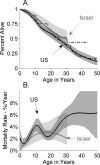How high are carrier frequencies of rare recessive syndromes? Contemporary estimates for Fanconi Anemia in the United States and Israel
- PMID: 21739583
- PMCID: PMC3140593
- DOI: 10.1002/ajmg.a.34087
How high are carrier frequencies of rare recessive syndromes? Contemporary estimates for Fanconi Anemia in the United States and Israel
Abstract
For many recessive genetic syndromes, carrier frequencies have been assessed through screening studies in founder populations but remain unclear in heterogeneous populations. One such syndrome is Fanconi Anemia (FA). FA is a model disease in cancer research, yet there are no contemporary data on carrier frequency or prevalence in the general United States (US) population or elsewhere. We inferred carrier frequency from birth incidence using the Hardy-Weinberg law. We estimated prevalence using birth incidence and survival data. We defined "plausible ranges" to incorporate uncertainty about completeness of case ascertainment. We made estimates for the US and Israel using demographic data from the Fanconi Anemia Research Fund and Israeli Fanconi Anemia Registry. In the US, a plausible range for the carrier frequency is 1:156-1:209 [midpoint 1:181]; we estimate that 550-975 persons were living with FA in 2010. For Israel, a plausible range for the carrier frequency is 1:66-1:128 [midpoint 1:93] in line with founder screening studies; we estimate that 40-135 Israelis were living with FA in 2008. The estimated US FA carrier frequency of 1:181 is significantly higher than the historical estimate of 1:300; hence, the gap may be narrower than previously recognized between the US carrier frequency and higher carrier frequencies of around 1:100 in several founder groups including Ashkenazi Jews. Assessment of cancer risks in heterozygous carriers merits further study. Clinical trials in FA will require co-ordination and innovative design because the number of living US patients is probably less than 1,000.
This article is a US Government work and, as such, is in the public domain in the United States of America. Published 2011 Wiley-Liss, Inc.
Figures


References
-
- Altay C, Alikasifoglu M, Kara A, Tuncbilek E, Ozbek N, Schroeder-Kurth TM. Analysis of 65 Turkish patients with congenital aplastic anemia (Fanconi anemia and non-Fanconi anemia): Hacettepe experience. Clin Genet. 1997;51(5):296–302. - PubMed
-
- Alter BP. Cancer in Fanconi anemia, 1927-2001. Cancer. 2003;97(2):425–440. - PubMed
-
- Alter BP, Nathan DG, Orkin SH, Look AT, Ginsburg D. Hematology of Infancy and Childhood. W.B. Saunders Inc.; Philadelphia: 2003. Inherited bone marrow failure syndromes. pp. 280–365.
Publication types
MeSH terms
Grants and funding
LinkOut - more resources
Full Text Sources
Miscellaneous

